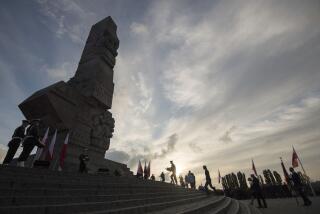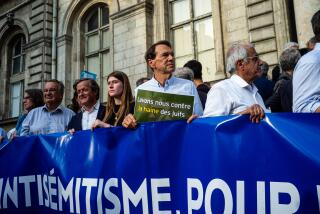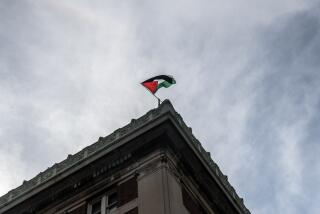Debate Over Guilt : Poland: The Ghosts of Its Jewish Past
CIECHANOWIEC, Poland — Matilda Kadyuschewic Meisler, my grandmother, died here in 1921, but it is impossible to find her grave now. The Jewish cemeteries of this little crossroads town on the Norzec River in the farmlands of northeast Poland are not empty, but they have no tombstones.
Stanislaw Krynski, the 30-year-old director of the local museum, has assembled a dozen or so Jewish tombstones neatly and prominently on the lawn alongside his museum, a former palace of the nobility.
“The Germans ripped out all the stones and used them to make roads and walls,” he said. “We found some of these stones last year when we knocked down the old post office building to build a new one. A farmhouse burned down not long ago, and, when the firemen came, they found a couple of tombstones in the ashes.”
Last Jew’s Death
Ciechanowiec was once a small center of lumbering and textile manufacturing. Before World War II, according to Krynski, it had a population of 5,000 to 6,000, of which 3,000 to 4,000 were Jews. Now, the population is 4,500, none Jewish.
“It’s a pity that you did not come before,” Krynski said. “I knew an old Jew in this town who probably remembered your family. But he died last year. Now there is no Jew in Ciechanowiec.”
Krynski, a serious man with a faint smile, showed us the traces of the past. Some antique wooden houses of the 19th Century lend the town a genteel and calming air. The old town market dominated by Jewish shops that my grandmother knew before she moved to Bialystok and married life, has made way for a neat and sterile administrative and commercial center, with few things to buy. A synagogue, the only one in town still standing, is now used as furniture factory warehouse.
Pine-Covered Cemetery
A mass grave of executed Jews is marked by a low fence; another mass grave of executed Jews is unmarked and strewn with dead branches and refuse; a Jewish cemetery is now covered by young pine trees.
“I can assure you that there is not a piece of stone there,” Krynski said of the cemetery. “I have walked over every foot of the ground searching.”
Polish intellectuals are caught up these days in an anguished debate over guilt. The ancient Jewish culture of Poland was demolished under the Nazi German occupation of World War II. Before the war, 3.5 million Jews lived in Poland, 10% of the total population, a Jewish community larger than any other in the world except that of the United States.
The overwhelming majority were killed during the war. After the war, almost all the survivors fled--from their memories, from Polish pogroms and from official anti-Semitism. Perhaps 6,000 Poles practice Judaism now or identify themselves as Jews.
No one accuses Poles of designing or operating the gas chambers of the Nazi camps such as Auschwitz, where several million Jews were exterminated on Polish soil. But the debate about guilt is going on nevertheless in the pages of Tygodnik Powzechny, the Roman Catholic weekly that is Poland’s most influential newspaper.
The debate began in January when Jan Blonski, a literary critic, commenting on two poems by Nobel laureate Czeslaw Milosz, concluded that the Poles, many of whom were anti-Semitic, had a “co-responsibility” for the genocide that took place on their soil.
Distinction Drawn
“Nobody in his right senses can maintain that the Poles--as a people--took part in the genocide,” Blonski wrote. But he then drew a distinction between participation and what he called co-responsibility.
“You can be co-responsible,” he said, “without actually lending your hand to a crime--first, by omission, or by failing to counteract firmly enough. Who can honestly say that counteraction was firm enough in Poland?
” . . . Had we acted more wisely, more nobly, more like Christians, then the genocide would probably have been more inconceivable, more difficult to carry out, and would certainly have been opposed more boldly.”
Blonski called on Poles “to purify our land” by “acknowledging our past in the light of truth.”
The article provoked a furious counterattack. Jerzy Turowicz, the editor, recently summed up the tenor of the letters of protest: “Not only Jews but also we Poles were murdered during the occupation; we first had to save ourselves; we saved the Jews and helped them whenever possible; we carry no blame. . . .
“Some of our correspondents even claim that there was no anti-Semitism in Poland, and if it did exist, it was justified.”
An angry article of rebuttal to Blonski came from Wladyslaw Sila-Nowicki, a 74-year-old lawyer who was an adviser to Solidarity, the now-outlawed free trade union movement.
“What could we do?” he said. “Attack the concentration camps with the forces we had? To suffer enormous losses and doom all those in the camps? Let no one lecture us about unfulfilled moral duties, and let not Mr. Blonski say, as he did in his extremely harmful and untrue piece, that we came close to the crime of genocide.”
In Paris, Alexander Smolar, an exiled Polish scholar who has written a good deal recently about Polish-Jewish relations, said that romantic nationalism prevented most Polish people from examining their past attitudes and behavior toward Jews.
“It is very difficult for the Poles, with all their historical ideas about their own moral purity,” he said, “to absorb all this moral ambiguity.”
My father, who died in 1986, remembered his home town of Bialystok in eastern Poland, now barely 30 miles from the Soviet border, as a pleasant, vibrant city of band concerts and fireworks in a park, of horse-drawn trolleys in streets lit by electric lamps, of Turkish baths on Friday night followed by succulent dinners of duck, gefilte fish, chopped carrots and enormous loaves of bread.
“It was a beautiful city, mostly with Jews,” he once said. “The people were so nice there.”
When he arrived in the United States in 1913 at the age of 14, he found the dirty, crowded, hard and lonely city of New York a depressing disappointment.
With the help of old photographs, the taped memories of my father, and a good guide, I found it possible to imagine what Bialystok might have been like in those days. But it was necessary to concentrate very hard, for, in fact, only a glimmer is really left. One can see the reconstructed Town Hall with its clock tower, a few reconstructed houses nearby, an original, antique building here and there, the towering Roman Catholic cathedral, but little else. Almost all the city was destroyed in World War II.
Grimy Industrial City
Bialystok is now a grimy, sprawling, polluted, ugly industrial city scarred with large, dispiriting block apartment buildings for its rootless workers. The restaurant at the Hotel Cristal, the main hotel in town, serves very little food at night but turns into a dance hall for gyrating, drunken Polish workers.
Henryk Crernicki, the 67-year-old former municipal controller, guided us around the city. Bialystok, according to Crernicki, is a city of 250,000 now. Before World War II, its population was 115,000, about 60% of it Jewish. The Jews owned most of the shops in town and all but two of the textile factories.
During the war, the population swelled to 140,000 as the Germans rounded up Jews from outside and walled them into the Bialystok ghetto. Now, Crernicki estimated, the city may have 15 to 20 Jews. Only three ordered matzo from Warsaw for Passover this year.
One of the four Jewish cemeteries remains relatively intact and a synagogue building still stands. It is used as a city social center, for Bialystok now has little more than commemorative plaques to show for its Jewish past. One plaque, in Polish and Yiddish, marks the site of a synagogue burned down June 24, 1941, by the Germans after they herded 3,000 Jews into it. My mother’s aunt and two cousins were among the dead.
There is a hoary family joke that Bialystok gave the world three famous men: Ludwik Zamenhof, the inventor of Esperanto; Maxim Litvinov, the Soviet foreign minister before World War II and the Soviet ambassador to the United States during the war, and my father, Meyer Meisler, the second fastest paperhanger in New York (one Bronx colleague was always acknowledged by my father to be faster).
Bialystok celebrates neither Litvinov (who passed out of favor in the Soviet Union after the war) nor my father, but there is much glorification of Zamenhof these days. A street is named after the Jewish eye doctor who created the international language, and a new bust of him has been placed in the former ghetto.
Posters in the town proclaim that Esperanto speakers will assemble in Warsaw and in Bialystok later this year to mark the 100th anniversary of the publication of Zamenhof’s book that first set down the rules of grammar and vocabulary of his language.
For two days, I tried hard to find the park that delighted my father as a boy. There is a large park in the center of town, a little deserted and desolate, with a massive, monstrous monument to the dead of World War II. It seemed possible that, in bygone days, it could have served as the scene of band concerts and fireworks. But Crernicki told me I was wrong.
“That was an old Jewish neighborhood,” he said. “The Germans moved all the Jews from here into the ghetto during the war and destroyed all the houses they left behind. After the war, we created a park out of the land.”
Despite the lack of a rabbi, a synagogue in Warsaw, preserved because it served as a stable during the war, still functions as a house of worship for the minuscule Jewish community in Poland. But Alexander Seidermann, its 75-year-old sexton, is pessimistic about the community’s future.
“The youngest Jew in Poland,” he said, “is 58 years old.”
This was an exaggeration, but it is true that there are few younger Jews in Poland. The best known of these few is Stanislaw Krajewski, a 37-year-old mathematician who is looked on by many Poles and foreigners as an intellectual but unofficial spokesman for Polish Jews.
The son of assimilated Polish Jews, Krajewski did not begin to delve into his Jewish identity and think about practicing Judaism until he was an 18-year-old student. He did so in reaction to a wave of official Polish government anti-Semitism in 1968.
“Compared to the real problems of Poland, the question of Polish-Jewish relations is not significant,” he said over dinner at his apartment in Warsaw. “It is a historical issue. Yet people get very emotional about it and talk about it a great deal. There are, after all, not many problems of Poland that are worth talking about.”
Catholic Curiosity
Krajewski said that Polish attitudes toward Jews these days range from the traditional, rabid anti-Semitism preached by some extreme organizations to what he called a philo-Semitism emerging among some young Poles. The new admiration for Jews, much of it naive and based on ignorance, he said, stems from a growing Polish Catholic curiosity about the Jewish religion, an admiration for the anti-Soviet policies of Israel, and “a feeling that whatever happened in the past must be better than what is happening now.”
Krajewski said he believes that the impetus for the present discussion about guilt came from a conference on Polish-Jewish relations held at Oxford University in Britain in 1984.
“It was the first time that Polish and Jewish scholars had sat down together to discuss the question,” Krajewski said. “It is very hard for Poles to face the anti-Semitism in their past, just as it is very hard for many Jews to understand how much the Poles themselves suffered during World War II.”
In 1905, the peace of Bialystok was shattered by a pogrom. Agents of the Russian Czar, who ruled that part of Poland in those days, provoked an uprising of Poles against the Jews, spreading the rumor that a Jew had thrown a rock at a statue of the Virgin Mary during a Holy Week procession.
My father, then 6 years old, and his family, were warned by a Polish farmer. They hid in the basement of their home for two days while the killing raged in the streets above. Kosher butchers, with their meat cleavers, defended the Jews but still failed to prevent the massacre of 127 of them.
The Jews of the city put up a small obelisk, with the chiseled names of the 127 victims, on a Bialystok street as a memorial a few years before my father left. The obelisk disappeared after World War II, but it suddenly reappeared last year and was placed in the Jewish cemetery. What happened is not clear.
“Some politician took the monument away because he wanted it for himself,” Crernicki, our guide in Bialystok, said. “But Jewish people finally pressured him to return it.”
That explanation is hard to accept.
“I’m not sure why it came back,” a Western diplomat in Warsaw said, “but it was probably removed in the first place because it was a bad reminder to the descendants of the Poles who took part in the pogrom of 1905.”
On my last night in Warsaw, the movie “Fiddler on the Roof” appeared on Polish government television. Perhaps politics had a hand in the decision to show it. The government of Gen. Wojciech Jaruzelski, seeking international approval in times of economic crisis, is trying to open channels to Israel and to American Jews.
The government had a much different political motivation in 1986 when it presented excerpts from Claude Lanzmann’s “Shoah,” the French-made, 9 1/2-hour documentary on the German extermination of several million Jews on Polish soil. The segments that put Poles in the worst light were shown on Polish television.
The government was using the documentary as evidence that the West, despite all its professions of support for dissident Polish movements like Solidarity, really did not like the Polish people.
“Fiddler on the Roof,” of course, is a far different movie from “Shoah” and ought to be taken lightly. The musical is exaggerated and oversentimental, an idealized, almost Walt Disneyish version of what Jewish life was like in Eastern Europe at the turn of the century. The characters are large but one-dimensional. The musical’s relationship to history is marginal. Anyway, it is set in Russia rather than Poland. Nothing about seeing it in Warsaw should have moved me.
Yet all the sentimentality on the screen engulfed me, and I could not prevent myself from feeling foolish and wrung. I had seen too much in Poland, and too little.
More to Read
Sign up for Essential California
The most important California stories and recommendations in your inbox every morning.
You may occasionally receive promotional content from the Los Angeles Times.










